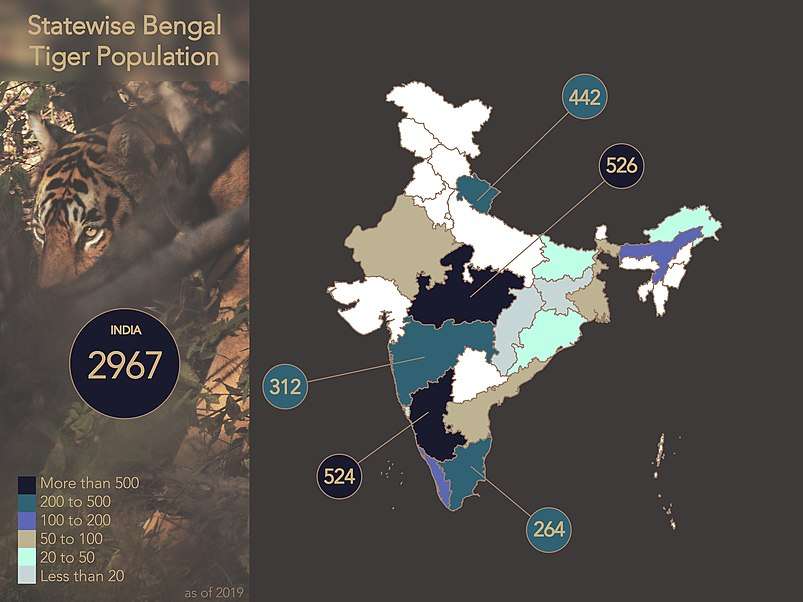Tiger reserves of India
There are 50[1] tiger reserves in India[2] which are governed by Project Tiger which is administrated by the National Tiger Conservation Authority (NTCA).
India is home to 80 percent of tigers in the world. In 2006, there were 1,411 tigers which increased to 1,706 in 2010, 2,226 in 2014 and 2967 in 2018.[3] The Indian increase played a big role in driving up global populations as well; the number of wild tigers globally rose from 3,159 in 2010 to 3,890 in 2016 according to World Wildlife Fund and Global Tiger Forum.[4]
Goals
71,027.1 km2 (27,423.7 sq mi) of declared reserves are operated by state forestry departments "to ensure maintenance of viable populations of the conservation dependent Bengal tigers in India". The tigers are maintained for their scientific, economic, aesthetic, cultural and ecological values and to preserve for all time areas of biological importance as a national heritage for the benefit, education and enjoyment of the people."[5]
Population assessment
By the year 2018, according to the National Tiger Conservation Authority, there were estimated only 2,967 tigers in existence in India.[6] The 2010 National Tiger Assessment estimated the total population of tigers in India at 1,706. As per Ministry of Environment and Forests, the tiger population in India stood at 2,226 in 2014 with an increase of 30.5% since the 2010 estimate. This exhaustive study indicated that better protected tiger source sites, especially tiger reserves, have maintained viable populations. However, the area occupied by tigers outside protected areas has decreased considerably. This demonstrates the need for corridors in order for tigers to move between source sites. The existing tiger reserves represent around one-third of India's high density forest area.[7] More tigers were killed in the first quarter of 2016 than in the entire previous year. This significant revelation comes at a time when the tiger census numbers are disputed by the scientific community. Some tigers get tamed and poorly fed by owners.
In 2010-11, the National Tiger Conservation Authority (NTCA) in partnership with the Wildlife Institute of India (WII) undertook an independent management effectiveness evaluation (MEE) of the 49 tiger reserves in the country. The reserves were categorized into four major categories. Madhya pradesh has the highest number of tigers(526) in the age group of 1.5 years with more than 408 big cats. Other states with significant populations included Uttarakhand (442), Karnataka (524), Tamil Nadu (229), Maharashtra (190), Assam (167), Kerala (136) and Uttar Pradesh (117).[8]
List of Tiger reserves

| Si No. | Tiger Reserve (Year of Creation) | State | Population of tigers, 2014[9] |
|---|---|---|---|
| 1 | Bandipur (1973–74) | Karnataka | 120 |
| 2 | Corbett (1973–74) | Uttarakhand | 215 |
| 3 | Kanha (1973–74) | Madhya Pradesh | 80 |
| 4 | Manas (1973–74) | Assam | 11 |
| 5 | Melghat (1973–74) | Maharashtra | 25 |
| 6 | Palamau (1973–74) | Jharkhand | 3 |
| 7 | Ranthambore (1973–74) | Rajasthan | 37 |
| 8 | Similipal (1973–74) | Odisha | 3 |
| 9 | Sunderbans (1973–74) | West Bengal | 68 |
| 10 | Periyar (1978–79) | Kerala | 20 |
| 11 | Sariska (1978–79) | Rajasthan | 9 |
| 12 | Buxa (1982–83) | West Bengal | 2 |
| 13 | Indravati (1982–83) | Chhattisgarh | 12 |
| 14 | Namdapha (1982–83) | Arunachal Pradesh | 11 |
| 15 | Dudhwa (1987–88) | Uttar Pradesh | 58 |
| 16 | Kalakad-Mundanthurai (1988–89) | Tamil Nadu | 10 |
| 17 | Valmiki (1989–90) | Bihar | 40 |
| 18 | Pench (1992–93) | Madhya Pradesh | 43 |
| 19 | Tadoba-Andhari (1993–94) | Maharashtra | 51 |
| 20 | Bandhavgarh (1993–94) | Madhya Pradesh | 63 |
| 21 | Panna (1994–95) | Madhya Pradesh | 17 |
| 22 | Dampa (1994–95) | Mizoram | 3 |
| 23 | Bhadra (1998–99) | Karnataka | 22 |
| 24 | Pench (1998–99) | Maharashtra | 35 |
| 25 | Pakke or Pakhui (1999-2000) | Arunachal Pradesh | 7 |
| 26 | Nameri (1999-2000) | Assam | 5 |
| 27 | Satpura (1999-2000) | Madhya Pradesh | 26 |
| 28 | Anamalai (2008–09) | Tamil Nadu | 13 |
| 29 | Udanti-Sitanadi (2008–09) | Chhattisgarh | 4 |
| 30 | Satkosia (2008–09) | Odisha | 3 |
| 31 | Kaziranga (2008–09) | Assam | 103 |
| 32 | Achanakmar (2008–09) | Chhattisgarh | 11 |
| 33 | Dandeli-Anshi Tiger Reserve(Kali) (2008–09) | Karnataka | 5 |
| 34 | Sanjay-Dubri (2008–09) | Madhya Pradesh | 8 |
| 35 | Mudumalai (2008–09) | Tamil Nadu | 89 |
| 36 | Nagarahole (2008–09) | Karnataka | 101 |
| 37 | Parambikulam (2008–09) | Kerala | 19 |
| 38 | Sahyadri (2009–10) | Maharashtra | 7 |
| 39 | Biligiri Ranganatha Temple (2010–11) | Karnataka | 68 |
| 40 | Kawal (2012–13) | Telangana | - |
| 41 | Sathyamangalam (2013–14) | Tamil Nadu | 72 |
| 42 | Mukandra Hills (2013–14) | Rajasthan | - |
| 43 | Nawegaon-Nagzira (2013–14) | Maharashtra | 7 |
| 44 | Nagarjunsagar Srisailam (1982–83) | Andhra Pradesh | 74 |
| 45 | Amrabad (2014) | Telangana | - |
| 46 | Pilibhit (2014) | Uttar Pradesh | 25 |
| 47 | Bor (2014) | Maharashtra | 5 |
| 48 | Rajaji (2015) | Uttarakhand | - |
| 49 | Orang (2016) | Assam | - |
| 50 | Kamlang (2016) | Arunachal Pradesh | 1 |
Future
In addition to existing reserves, the in-principle approval has been accorded by the National Tiger Conservation Authority for the creation of four new tiger reserves, and the sites are: Ratapani Tiger Reserve (Madhya Pradesh), Sunabeda Tiger Reserve (Odisha), and Guru Ghasidas (Chhattisgarh). Final approval has been accorded to Kudremukh National Park (Karnataka) for declaring as tiger reserves by States. The State Governments have been advised to send proposals for declaring the following areas as tiger reserves: (i) Suhelwa (Uttar Pradesh), (ii) Mhadei Sanctuary (Goa), (iii) Srivilliputhur Grizzled Squirrel Wildlife Sanctuary / Megamalai Wildlife Sanctuary / Varushanadu Valley (Tamil Nadu), (iv) Dibang Wildlife Sanctuary (Arunachal Pradesh) and (v) Cauvery-MM Hills (Karnataka).[10]
References
- "Archived copy". Archived from the original on 2015-05-25. Retrieved 2016-02-28.CS1 maint: archived copy as title (link)
- "Core buffer areas". Government of India. Archived from the original on 25 May 2015. Retrieved 22 January 2016.
- "India's tiger population sees 33% increase". BBC. 29 July 2019.
- "2967 - WHAT THE NEW GLOBAL TIGER NUMBER MEANS". WWF. 2016.
- "Project Tiger" (PDF). Delhi: Government of India. Retrieved 22 January 2016.
- Y.V. Jhala; R. Gopal; Q. Qureshi, eds. (2008). Status of the Tigers, Co-predators and Prey in India (PDF) (Report). National Tiger Conservation Authority, Govt. of India, New Delhi, and Wildlife Institute of India, Dehradun. TR 08/001. Archived from the original (PDF) on 2013-06-02.
- "Tiger Estimate in India" (PDF). Public Information Brochure. New Delhi: Ministry of Environment and Forests, GOI. 28 March 2011. p. 9. Retrieved 21 June 2011.
- "India's tiger population rises". Deccan Chronicle. 15 January 2015.
- "Population of tigers" (PDF).
- http://timesofindia.indiatimes.com/home/environment/flora-fauna/In-principle-approval-given-to-4-new-tiger-reserves-Government/articleshow/51211020.cms
| Wikimedia Commons has media related to Tiger reserves of India. |
